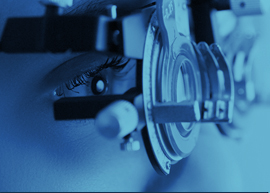Dr. Young Answers Your Eye Care Questions
Q: What type of patients do you normally see?
A: We see all kinds of patients. Many patients come in because they noticed a change in vision. Sometimes during screenings at school the students will be notified that they need to get their eyes examined.
Some patients thought they were seeing just fine, but failed a vision test at the MVA, or during a yearly physical. Many patients have been coming to us for many years. Others come to us for their first eye exams. A great deal of our patients come to us from friends and family who have recommended us, and they bring their families. We see children, young adults, adults and seniors.
Q: What are some of the things you will go over during a comprehensive eye exam?
A: During a complete eye exam, your Cove Eyecare doctor will determine your prescription for eyeglasses and will check your eyes for eye diseases, determine how your eyes work together as a team and evaluate your eyes as an indicator of your overall health.
A comprehensive eye exam includes a number of tests and procedures to examine and evaluate the health of your eyes and the quality of your vision. These tests range from simple ones, like having you read an eye chart, to complex computerized instruments that provide detail digital images of the retina and the complete eye.
Some of the tests we may perform are:
- Visual Acuity Tests
- Color Blindness Test
- Cover Test
- Ocular Motility (Eye Movements) Testing
- Stereopsis (Depth Perception) Test
- Retinoscopy
- Refraction
- Autorefractors and Aberrometers
- Slit Lamp Exam
- The Glaucoma Test
- Pupil Dilation
- Visual Field Test
Cove Eyecare doctors recommend you have a complete eye exam every year.
Q: What is an autorefractor?
A: One of the components of the eye exam is to establish the manifest refraction. We get this by using an instrument call an autorefractor. The autorefractor is a computer that uses light to bounce off of the back of the eye. Light travels in through the cornea, the lens, the retina and bounces back out. This takes a measurement of the length of the eye from front to back, and measurements of the corneal curvatures, and give us the prescription you need. Once we have this we will do the suggested refraction, where the doctor will ask you which picture looks better/clearer to you. We will do each eye separately, testing near as well as distance vision. This way we refine the prescription you will need to see the best you possibly can.
Q: What is the difference between spectacle lenses and other lenses?
A: Spectacle lenses are the part of your glasses which have the prescription to give you the best vision possible for you. They are the product of the prescription we arrived at during your eye exam – During the refraction, we refine the prescription and determine your spectacle lens prescription.
Q: What is glaucoma?
A: Glaucoma is a neurodegenerative disease which affects the optic nerve (which is the connection between the eye and the brain).
Q: Do you test for glaucoma during a regular eye exam?
A: Dr. Young: Yes. During a regular eye examination, we look for several different factors which can show symptoms of glaucoma.
We look at the optic nerve. That is the most important thing when we are trying to rule out the presence of glaucoma. Does the optic nerve look healthy? Does this optic nerve have an anatomy or appearance suggestive of the glaucoma process? Then we look at pressure readings that are taken inside the eye.
However, it’s not so simple to diagnose. It’s like high blood pressure. One reading doesn’t give you the full picture. We have more advanced testing to determine conclusively if the patient does have glaucoma or not.
Q: What part of the eye is affected by Macular Degeneration?
A: Macular Degeneration affects the most sensitive part of the retina, which is called the macula. It is a condition where the outer layers of the retina become disrupted, which in turn affects the person’s ability to read, drive, and recognize faces.
There are two forms of Macular Degeneration. A dry form which is most common. This affects about 90% of people diagnosed with Macular Degeneration. The other is a wet form, or hemorrhagic type of Macular Degeneration.
This wet form if more visually disabling and more aggressive of the two. There are a percentage of people who transition from dry Macular Degeneration to wet Macular Degeneration and that’s why Macular Degeneration needs to be monitored very carefully.
We check the retina, and if we determine the patient has formations suggestive of Macular Degeneration, we will then do further imaging studies and genetic testing, called the Macula Risk Test, which allows us to determine a person’s specific phenotype for the disease, meaning the person’s particular genetic makeup of the disease. We like to do this test because it helps us determine which nutritional supplements are going to optimize their vision and decrease the chances for vision loss.





